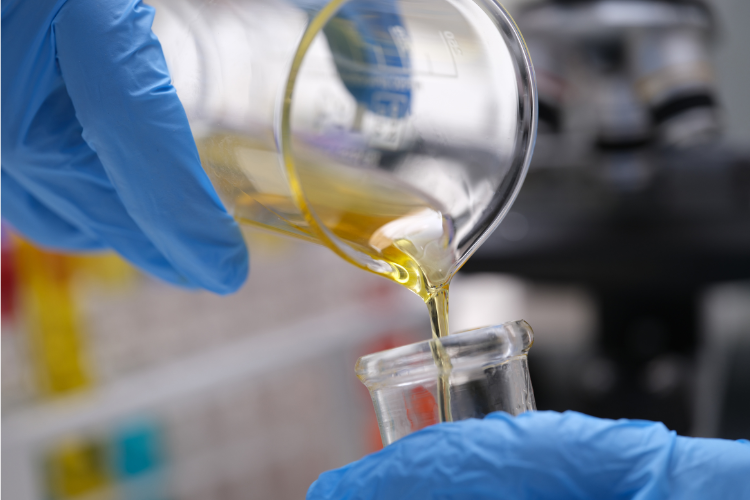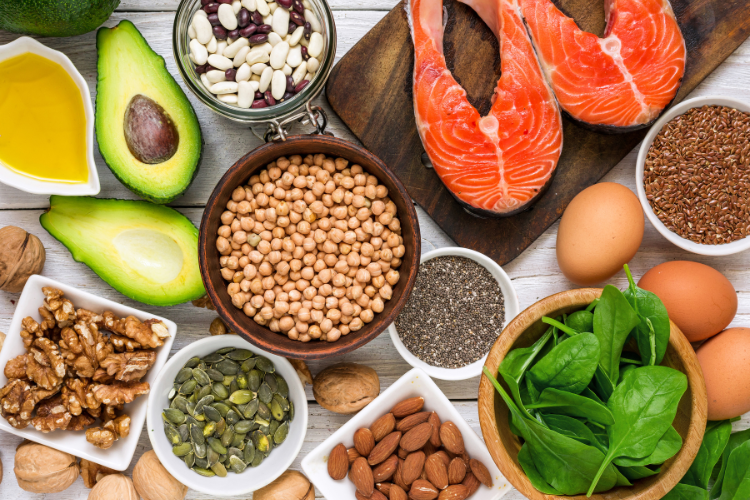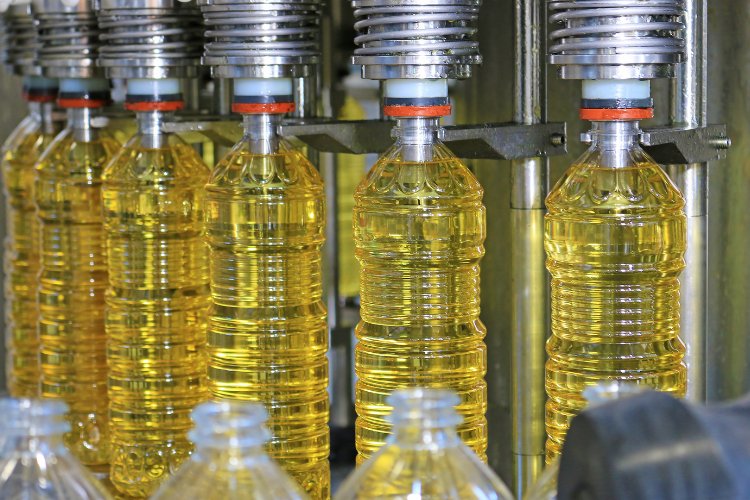Blog
Linoleic Acid: The Hidden Dangers of Vegetable & Seed Oils
Let’s kick things off by shedding light on the unsung hero (or villain) of our kitchens: linoleic acid. Often hailed as an essential fatty acid, linoleic acid is a polyunsaturated omega-6 fatty acid found in abundance in vegetable and seed oils. While it plays a crucial role in various bodily functions, there’s a dark side to its overconsumption, especially through the prevalent use of vegetable oils in our diets.
1. The Good Side of Linoleic Acid
Linoleic acid, often hailed as an unsung hero among fatty acids, plays a pivotal role in supporting various bodily functions, contributing to overall well-being.
Skin Health Booster
Linoleic acid is a key player in maintaining healthy skin. It’s a vital component of the skin’s lipid barrier, helping to lock in moisture and prevent dehydration. Including linoleic acid in your diet can contribute to a natural radiance and suppleness.
Immune System Support
This essential fatty acid doesn’t just stop at skincare; it’s also a crucial ally for your immune system. Linoleic acid aids in the production of prostaglandins, which regulate immune responses, ensuring your body can effectively defend itself against invaders.
Brain Function and Development
Linoleic acid is not just about the skin deep benefits; it’s a key player in the development and maintenance of the nervous system. It supports brain function, playing a role in neurotransmitter synthesis and cognitive health.
Heart Health
Believe it or not, linoleic acid contributes to heart health. It helps regulate cholesterol levels, maintaining a balance that supports cardiovascular well-being. In moderation, this omega-6 fatty acid can be a friend to your heart.
Energy Source
Linoleic acid is an excellent source of energy for the body. It’s a component of cell membranes and aids in the transportation of nutrients across cells, ensuring your body efficiently converts food into energy.
It’s important to note that, like many things in life, balance is key. While these benefits highlight the positive role linoleic acid can play in our health, it’s equally crucial to be mindful of its intake to avoid potential downsides, and especially through vegetable and seed oils.
2. The Rise of Vegetable and Seed Oils
In the not-so-distant past, our kitchen shelves were dominated by traditional fats like butter, lard, and even coconut oil. However, a culinary revolution took place as the mid-20th century unfolded, ushering in a new era of cooking oils – the vegetable and seed oils.
Marketing Marvels
This shift wasn’t just a coincidence. Clever marketing campaigns in the mid-20th century positioned vegetable oils as the healthier alternative than more traditional fats such as butter, lard and even coconut oil. The push to reduce saturated fat consumption in the name of heart health saw vegetable oils rise to stardom, with promises of a lighter, heart-friendly option.

Industrialization of Agriculture
The widespread adoption of vegetable and seed oils can be attributed to the industrialization of agriculture. Mass production of crops like soybeans and corn became economically viable, paving the way for the large-scale extraction of oils. These oils, particularly soybean oil, became staples in the processed food industry.
Economic Factors
Vegetable and seed oils also offered economic advantages. They were not only cheaper to produce on a large scale but had a longer shelf life compared to traditional fats. This made them attractive to both manufacturers and consumers, aligning with the fast-paced, convenience-oriented lifestyle that was gaining traction.
Health Halo Effect
As health-consciousness gained momentum, vegetable and seed oils rode the wave of the ‘health food’ trend. Olive oil and canola oil, for instance, were celebrated for their perceived health benefits, further solidifying the position of vegetable oils in modern cooking.
Versatility in Cooking
Vegetable and seed oils brought with them a high smoke point, making them versatile for different cooking methods, including frying. This versatility made them go-to choices for chefs and home cooks alike.
The rise of vegetable and seed oils was not just a change in cooking practices; it was a cultural shift fueled by a complex interplay of health trends, economic factors, and the evolving food landscape. Little did we know that this shift would have profound implications for our health in the years to come.
3. The Linoleic Acid Overload
In our modern era of convenience and processed foods, we find ourselves unintentionally caught in the crossfire of a nutritional imbalance, with linoleic acid taking center stage.
Unprecedented Dietary Shifts
As we embraced the convenience of processed and pre-packaged foods, our diets underwent a seismic shift. All vegetable oils: soybean oil, corn oil, sunflower oil, and their counterparts… are rich in linoleic acid. The problem arises not from linoleic acid itself, but from the overwhelming quantity in which we now consume it.
Omega-3 vs. Omega-6 Imbalance
The human body requires a delicate balance between omega-3 and omega-6 fatty acids. Historically, this balance was maintained through a diet rich in both. However, the surge in vegetable oil consumption has disrupted this equilibrium. The result? An overload of omega-6 fatty acids, including the linoleic acid variety, tipping the scales unfavorably.
Inflammatory Conundrum
Linoleic acid, when consumed in moderation, is not inherently harmful. However, an excess of omega-6 fatty acids, coupled with a deficiency in omega-3s, triggers a pro-inflammatory environment in the body. Chronic inflammation has been linked to a host of health issues, from cardiovascular problems to autoimmune disorders.
Processed Food Predicament
The linoleic acid overload is exacerbated by the pervasive use of vegetable oils in processed and fast foods. From your favorite snacks to restaurant meals, these oils find their way into a significant portion of our daily caloric intake, often without us realizing it.
Impact on Cellular Health
Linoleic acid is a vital component of cell membranes, playing a crucial role in maintaining their integrity. However, excessive linoleic acid, particularly when unbalanced with omega-3s, can lead to compromised cell function and potential long-term health consequences.

4. Inflammation and Its Ramifications
Inflammation, once a natural defense mechanism in the body, takes a dark turn when chronic, with linoleic acid overload being one of the potential culprits.
The Inflammatory Symphony
Inflammation is the body’s response to injury or infection. It’s like a symphony of protective measures – swelling, heat, and redness – orchestrated to heal and defend. However, when this symphony plays on a loop, transitioning from acute to chronic inflammation, it becomes a cause for concern.
Cardiovascular Chaos
Chronic inflammation is linked to atherosclerosis, the hardening and narrowing of arteries. The excessive presence of inflammatory markers can contribute to the formation of plaques, increasing the risk of heart diseases and strokes.
Weighty Matters – Obesity Connection
There’s a dance between inflammation and obesity. Excessive fat tissue can release inflammatory chemicals, creating a cycle where inflammation promotes obesity and vice versa. This intertwined relationship is a significant concern in the linoleic acid-heavy diet scenario.
Joint Pains and Autoimmune Ailments
Inflammation plays a central role in autoimmune disorders like rheumatoid arthritis. The immune system, confused by chronic inflammation, may start attacking healthy cells, leading to joint pains and other autoimmune manifestations.
The Brain on Fire
Neuroinflammation, a lesser known but equally critical consequence, is implicated in various neurological disorders. From Alzheimer’s to depression, the inflammatory cascade can impact brain health and function.
Insulin Resistance and Diabetes
Chronic inflammation is associated with insulin resistance, a precursor to type 2 diabetes. The inflammatory milieu interferes with normal insulin signaling, contributing to elevated blood sugar levels.
Understanding the ramifications of inflammation is not about painting it as the ultimate villain but recognizing its role in various health issues. The linoleic acid overload-induced inflammation is a wake-up call to reevaluate our dietary choices and make conscious decisions to break free from the inflammatory loop for a healthier, harmonious life.
5. The Culprit Oils
Let’s deep-dive into the world of the notorious culprit oils – the key players in the linoleic acid overload.
Soybean Oil – The Sneaky Infiltrator
Soybean oil, a staple in processed foods, deserves a spotlight. High in linoleic acid, it stealthily finds its way into our diets through snacks, salad dressings, and even restaurant fare. Its ubiquity makes it a chief contributor to the imbalance in our omega-3 to omega-6 ratio.
Corn Oil – The Cornucopia of Linoleic Acid
Derived from corn kernels, corn oil is another linoleic acid heavyweight. Often used in frying due to its high smoke point, it has become a kitchen staple. However, its overuse tips the scales in favor of omega-6 fatty acids, adding to the inflammatory load.
Sunflower Oil – A Sunshine of Linoleic Acid
Despite its sunny name, sunflower oil casts a shadow on our health when overused. Widely used in cooking and as a base for many processed foods, it contributes significantly to the excess linoleic acid conundrum.
Canola Oil – The ‘Healthy’ Misnomer
Marketed as a heart-healthy alternative, canola oil often takes the spotlight in health-conscious kitchens. However, its linoleic acid content, though lower than some counterparts, still contributes to the overall imbalance when used excessively.
Cottonseed Oil – The Soft Unused Byproduct
Cottonseed oil, as the name suggests, is extracted from cotton seeds. It’s often used in processed foods and is a primary ingredient in shortening/margarine. It was in fact the first seed oil industrially produced, since cotton seeds were an unused byproduct of American cotton production and cotton conglomerates wanted to make some extra cash from the otherwise wasted seeds.
Vegetable Oil Blend – The Silent Saboteur
The generic ‘vegetable oil’ blend often combines oils like soybean, corn, and sunflower, creating a linoleic acid powerhouse. It’s a common denominator in many packaged foods and restaurant dishes, making it challenging for consumers to gauge their linoleic acid intake.
Understanding these culprit oils goes beyond demonizing them; it’s about making informed choices. Opting for healthier alternatives like olive oil, avocado oil, or even coconut oil can be a step towards regaining balance and steering clear of the potential health risks associated with the linoleic acid overload. It’s time to read those ingredient labels and take charge of what goes into our kitchens!
6. Balancing the Fats
Achieving a balanced omega-3 to omega-6 ratio means encouraging the inclusion of healthier fats like olive oil, avocado oil, and omega-3-rich sources such as fatty fish, flaxseeds, and walnuts.
Embracing Omega-3 Rich Sources
To counteract the linoleic acid overload, incorporate omega-3 rich sources into your diet. Fatty fish like salmon, mackerel, and sardines are excellent choices. These omega-3 fatty acids, including EPA and DHA, not only offer a counterbalance to omega-6 but also come with their own set of health benefits, supporting heart and brain health.
Hello, Healthy Monounsaturated Fats
Opt for cooking oils that are rich in monounsaturated fats, like olive oil and avocado oil. These oils not only provide a more balanced fatty acid profile but also come with antioxidant properties, adding an extra layer of health benefits.
Nuts and Seeds – Nature’s Balanced Snack
Snack on nuts and seeds, such as walnuts, flaxseeds, and chia seeds. These little powerhouses are not only packed with healthy fats but also bring omega-3s to the table, promoting a more harmonious balance between the different types of fatty acids.

Avocado Love – Creamy Goodness, Healthy Fats
Avocado, with its creamy texture and rich taste, is a fantastic addition to your diet. It’s not only delicious but also a source of monounsaturated fats, contributing to a healthier fat profile.
Coconut Oil – A Different Kind of Saturated Fat
While predominantly a saturated fat, coconut oil is unique. It contains medium-chain triglycerides (MCTs), which are metabolized differently than other saturated fats. Including moderate amounts of coconut oil can provide a diverse set of fatty acids.
Limiting Processed and Fast Foods
One of the easiest ways to balance your fats is by reducing your intake of processed and fast foods. These often contain an excess of unhealthy oils, contributing to the omega-6 overload. Opt for home-cooked meals using healthier oil alternatives.
Mindful Consumption – Read Those Labels
Become a label detective. Scan ingredient lists for the types of oils used in packaged foods. Choosing products with healthier oil options contributes to the overall fat balance in your diet.
By incorporating these changes, you’re not just avoiding the pitfalls of excessive linoleic acid but also enhancing your overall well-being. Balancing fat sources is not just a dietary choice; it’s a lifestyle shift towards a healthier, more sustainable approach to nutrition.
7. Practical Tips for a Healthier Diet
Swap Cooking Oils
Start by replacing vegetable oils with healthier alternatives in your cooking. Opt for oils rich in monounsaturated fats, like olive oil or avocado oil. These oils not only bring a delicious flavor to your dishes but also contribute to a more balanced fatty acid profile.
Choose Smartly at the Grocery Store
When shopping, be mindful of the cooking oils used in packaged products. Look for items that use healthier oils like olive, avocado, or coconut oil. Avoid products with soybean, corn, or sunflower oil as primary ingredients. At Bali Buda, we are committed to only source, sell and serve good quality and healthy oils!
DIY Salad Dressings
Instead of store-bought salad dressings that often contain vegetable oils, make your own at home. Mix olive oil with balsamic vinegar or lemon juice and add herbs for flavor. It’s a tastier and healthier alternative.

Explore Cooking Methods
Experiment with cooking methods that don’t rely heavily on oils. Grilling, steaming, baking, and roasting are fantastic options. They retain the natural flavors of the food without drowning it in excessive oils.
Air Frying – The Low-Oil Wonder
Invest in an air fryer for a crispy texture without the need for deep frying. This method requires significantly less oil while still giving you that delightful crunch.
Transition to Whole Foods
Embrace a diet rich in whole, unprocessed foods. Fresh fruits, vegetables, lean proteins, and whole grains not only provide essential nutrients but also reduce your reliance on cooking oils found in processed and fast foods.
Incorporate Omega-3 Rich Foods
Introduce omega-3 rich foods into your meals. Include fatty fish like salmon, chia seeds, flaxseeds, and walnuts to enhance the omega-3 to omega-6 balance in your diet.
Takeaway
Remember, small changes can lead to significant improvements in your overall health. By gradually implementing these tips, you’ll not only reduce your intake of vegetable oils but also foster a more balanced and nutritious approach to your diet.

 Indonesia
Indonesia
